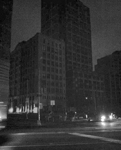11.06.2012
Emergency Power for Lighting & Essential Services
 I found myself watching Hardcore Pawn on TruTV the other night while supper was in the oven. In this episode, a storm runs through Detroit causing a power outage, and I quickly thought about how Faith Technologies could have helped with their electrical and emergency systems.
I found myself watching Hardcore Pawn on TruTV the other night while supper was in the oven. In this episode, a storm runs through Detroit causing a power outage, and I quickly thought about how Faith Technologies could have helped with their electrical and emergency systems.
While the store occupants wait in the dark, the store owner tries to manually start its generator. From the point of the view of someone who does emergency egress calculations, it appeared their only emergency plan was the flashlights held by their employees. When the generator finally kicks in, ALL of the lights come back on and the computer and servers begin to boot up. It does not appear there was a UPS or inverter to protect the computer data and prevent data loss or corruption. Nor was there egress lighting in place to run until the generator kicked in. And finally, the whole system appeared to be running off of the generator which made me curious as to how long it could carry the load, and how this system could possibly meet the code requirements regarding life safety. The owners concerns to protect their property and money during the blackout far overshadowed any concern they may have had for the wellbeing of their customers and employees in the store.
As electrical designers, our goal should be to not only meet, but exceed the code requirements for life safety to ultimately protect lives and the owner’s property. Lighting is multi-dimensional and complex in the design process, but the end result needs to simple and user-friendly. I spend most of my day focused on the lighting aspects of a building, asking the questions:
- Does the lighting add to the architectural feel – or detract from it?
- Does it perform as expected?
- Is it a reasonable solution to meet the needs and function of the building?
- How is it controlled under normal use and emergency situations?
These are the everyday thoughts of an electrical designer, and as you’ve learned they are never far from my mind, even in times when I’m watching TV waiting for supper to be done.
Footnote by Author: This was written prior to the devastation Hurricane Sandy brought to the northeast coast. After watching NYU Hospital transfer its critical care patients during the storm, it was evident their primary and secondary service and emergency generator all failed within a 30 minute period. While I don’t know what caused the generator fail, it served as an important reminder to me that as an electrical designer, I need to think through all the possible scenarios a building could be exposed to and verify the lighting and critical power systems will function in both normal and emergency conditions. Our efforts may just save a life.
If you enjoyed this blog article, please subscribe to stay up to date on the latest industry news from our experts at Faith Technologies.



